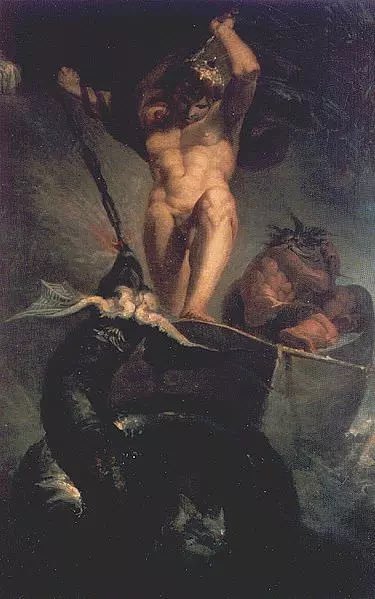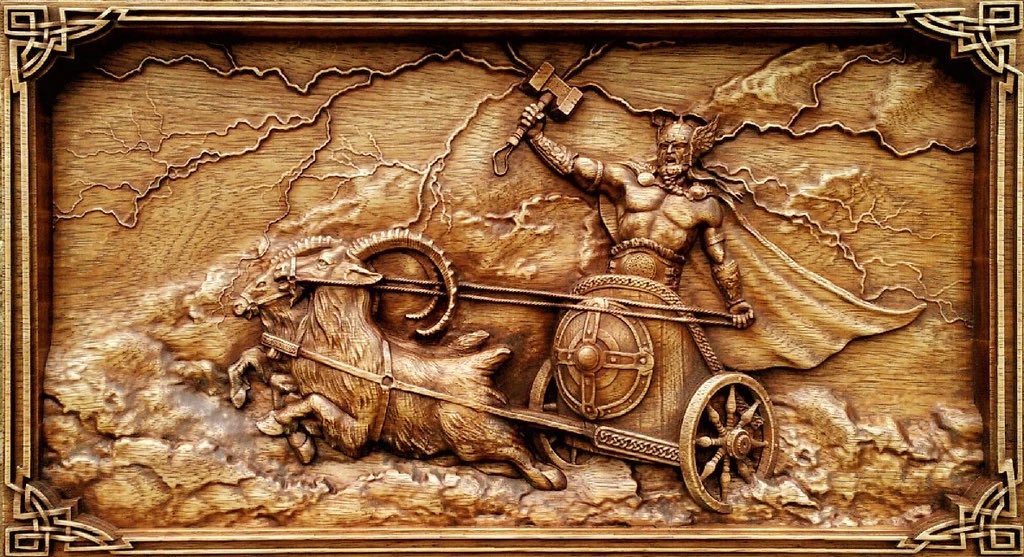Meet Thor (Old Norse: Þórr) is the Norse god of thunder, the sky, and agriculture. He is the son of Odin, chief of the gods, and Odin's consort Jord (Earth) and husband of the fertility goddess Sif, who is the mother of his son Modi and daughter Thrud; his other son, Magni, may
be the offspring of a union with the giantess Jarnsaxa. Thor was the defender of Asgard, realm of the gods, and Midgard, the human realm, and is primarily associated with protection through great feats of arms in slaying giants.
The majority of the tales featuring Thor, in fact,
The majority of the tales featuring Thor, in fact,
put him in conflict with a giant or with his nemesis the Midgard Serpent (Jörmungandr, the “huge monster”), a monstrous snake who coils and twists itself around the world. Like almost all of the Norse gods, Thor is doomed to die at Ragnarök, the end of the world and twilight of
the gods, but falls only after killing the great serpent with his powerful hammer Mjollnir, dying to its poison; his sons Magni and Modi survive Ragnarök along with a small number of other gods and inherit his hammer which they use to restore order.
He developed from the earlier Germanic god Donar and became the most popular deity of the Norse pantheon. Thor continues as a popular god in the present day, too, and the modern English and German words for the fifth day of the week – Thursday and Donnerstag – both allude to Thor
Donar (“Thor’s Day”/“Donar’s Day”). He was thought to have ruled the sky from his land of Þrúðvangr (“Power-Field” or “Plains of Strength”) where he built his great hall of Bilskírnir, a palace of 540 rooms.
Thor’s popularity reached its height during the Viking Age (c. 790-1100 CE) at which time he was considered the greatest rival to Christ when, roughly from the 10th century CE onwards, Christianity was introduced to Scandinavia. More amulets and charms of Thor’s hammer date from
the period when Christianity and the Norse religion were in contention than from any other. Christianity finally prevailed and the cult of Thor was gradually replaced by the new religion by the 12th century CE.
Thor functioned primarily as a protector-god, although stories concerning him also explained natural phenomena, thus linking him with the etiological type of myth (one which explains how some aspect of life came to be). He was said to burst forth from his great hall in his
chariot, drawn by two male goats – Tanngnjóstr (Tooth Gnasher) and Tanngrísnir (Snarl Tooth) – who could be killed and eaten by the god and then brought back to life the next day as long as their bones remained unbroken. The roar of thunder was the rumble of Thor’s chariot’s
wheels across the vault of the heavens and, in another story, he is credited with creating tides.
For the most part, however, he was invoked for protection and problem-solving. Scholar Preben Meulengracht Sørensen comments that Thor “was master of thunder and lightning, storm and
For the most part, however, he was invoked for protection and problem-solving. Scholar Preben Meulengracht Sørensen comments that Thor “was master of thunder and lightning, storm and
rain, fair weather and crops, and the pagans sacrificed to him when threatened by hunger or disease” (Sawyer, 203). He had three magical items which helped him defend Asgard and Midgard: his hammer Mjollnir, his belt of strength Megingjörð (which doubled his strength when he wore
it), and his great iron gloves which he needed to wield his hammer.
Thor was invoked to seal business contracts and consecrate marriages, for agricultural abundance, for protection during voyages (especially at sea) and for victory in battle, but he seems to have been called
Thor was invoked to seal business contracts and consecrate marriages, for agricultural abundance, for protection during voyages (especially at sea) and for victory in battle, but he seems to have been called
upon whenever any need arose. Sørensen notes: The relationship with the pagan gods had been a sort of friendship, a contract by which man sacrificed to the gods and was entitled to their support in return…The Icelandic Landnamabok (The Book of Settlements) relates that
Helgi inn Magri, who settled Iceland in about 900, believed in Christ but invoked Thor when in distress at sea. He also asked Thor to show him where to build his new farm, but he named it after Christ. (Sawyer, 223)
The introduction of Christianity to Scandinavia, at first, did nothing to diminish the importance of Thor in people’s lives. The god continued to be invoked throughout the greater part of the Viking Age as evidenced not only by the amulets and charms mentioned above but by
engravings, images, statuary and the stories which continued to be told about him. In all of these stories, Thor’s attributes are his previously mentioned three magical items – the hammer Mjollnir, the belt Megingjörð, and his iron gloves, out of which Mjollnir is the most
characteristic one – as well as this goat-drawn chariot. These items embellish Thor's great strength, which is his main feature, and Thor also has a quick temper and shows impatience for following others’ rules. He is never depicted as a subtle or careful deity and prefers direct
action over discussion or planning in solving any problem. Thor is completely without guile or the capacity to deceive and so cannot recognize these qualities in others; as a result, he is often tricked by magical spells or shape-shifting entities which cause things to appear:
other than they are.
Contrary to the popular image of Thor in the present day from Marvel comic books and films, he was not the brother of Loki and is never depicted as clean-shaven or blonde-haired except in chapter 3 of the Prose Edda (composed c. 1220 CE), a mythography of
Contrary to the popular image of Thor in the present day from Marvel comic books and films, he was not the brother of Loki and is never depicted as clean-shaven or blonde-haired except in chapter 3 of the Prose Edda (composed c. 1220 CE), a mythography of
earlier Norse myths reworked by the Icelander Snorri Sturluson into one structured account, written from a Christian context. Elsewhere, and in almost every image, Thor is always shown with long red hair and a great beard, often as not leaping into battle against giants or
killing dwarves without pausing to consider alternatives to violence. He is closely associated with water in many of the myths and is depicted rowing out further into the sea than others have gone and also crossing dangerous rivers – both aspects of his role as a protector god
who removes boundaries or goes before a believer as a guide.
Viking Age Scandinavians especially revered Thor not only as a guide across the seas and protector from storms, but as a champion in battle. Scholar H. R. Ellis Davidson writes
Viking Age Scandinavians especially revered Thor not only as a guide across the seas and protector from storms, but as a champion in battle. Scholar H. R. Ellis Davidson writes
Of all the gods, it is Thor who seems the characteristic hero of the stormy world of the Vikings. Bearded, outspoken, indomitable, filled with vigor and gusto, he puts his reliance in his strong right arm and simple weapons. He strides through the northern realm of the gods, a
fitting symbol for the man of action
Thor was not just the preferred god of the Viking warrior, however, as his strength and direct response to any given problem were equally appealing across the spectrum of Viking Age social classes. A housewife could call upon Thor for help
Thor was not just the preferred god of the Viking warrior, however, as his strength and direct response to any given problem were equally appealing across the spectrum of Viking Age social classes. A housewife could call upon Thor for help
with domestic challenges just as a farmer, a weaver, or a brewer would with their own difficulties and, as evidenced by his popularity, Thor would help them. Thor therefore became the Norse god of the everyman; the common-sense, no-nonsense deity anyone could relate
to and everyone could depend on.
The stories which feature the god, besides noting his strength and impatience with delays, all emphasize his reliability. Even when Thor is tricked our outsmarted, his past victories and assurance of future triumphs excuse him; he may not win a
The stories which feature the god, besides noting his strength and impatience with delays, all emphasize his reliability. Even when Thor is tricked our outsmarted, his past victories and assurance of future triumphs excuse him; he may not win a
battle but will eventually win the war. This concept is clearly explained in Chapter 44 of the Prose Edda when the story-teller High responds to a question about Thor’s victories:
Although some things, because of their power or strength, have prevented Thor from being victorious, there is no need to tell about them, not least because everybody ought to keep in mind that there are so many examples where Thor is mightiest
Even though High claims that the stories where Thor does not win are not worth being told, a number of these are among the most famous. One of these has to do with the Castle of the giant Utgarda-Loki and the three tricks played on Thor. Thor frequently traveled with his human
servant Thjalfi or with Loki but, on this journey, he was accompanied by both. They encounter a giant named Skrýmir in the forest who offers to carry the food bag but ties it so tightly that Thor cannot open it. Three separate times Thor attacks Skrýmir with his hammer while the
giant is sleeping but with no effect; each time Skrýmir wakes up and asks if perhaps a leaf or acorn has fallen on his head.

 Read on Twitter
Read on Twitter




